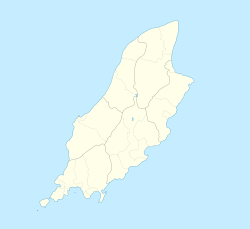Knock y Doonee facts for kids

Knock y Doonee keeill, with Viking Ship Burial site on the hilltop in the distance
|
|
| Location | Knock y Doonee Andreas |
|---|---|
| Region | Isle of Man |
| Coordinates | 54°23′34″N 4°27′29″W / 54.392916°N 4.458138°W |
| History | |
| Periods | Medieval, Viking |
| Site notes | |
| Public access | No |
Knock y Doonee (also called Knock-e-Dhooney) is a very old and important historical place. It is found in Andreas on the northern coast of the Isle of Man. People have used this site for special ceremonies for hundreds of years.
Archaeologists have dug here and found amazing things. They uncovered a Christian keeill (which is a small chapel). Inside the keeill, they found a special stone called an ogham stone with writing in two languages. They also found a Christian stone cross. On a nearby hill, they discovered a Viking Age boat burial.
Contents
Discovering Ancient Sites at Knock y Doonee
Two different ancient sites have been dug up at Knock y Doonee. The first was the Keeill site, explored in 1911. This dig was led by P. M. C. Kermode and the Manx Archaeological Survey.
Later, in 1927, Kermode returned to Knock y Doonee. By then, he was the director of the Manx Museum. He dug into a mound on a hilltop about 300 meters away. There, he found a Viking Age boat burial with many items buried alongside it.
Exploring the Knock y Doonee Keeill
The remains of an ancient keeill were found at this spot. A keeill is a small, simple chapel. Most keeills on the Isle of Man were built between the 6th and 12th centuries. Many keeills have been lost or destroyed over time. There might have been over three hundred, but now fewer than thirty-six still have parts standing. Knock y Doonee's keeill is one of the best preserved.
Experts think this keeill is very old, possibly built between 400 and 600 AD. We don't know how many times it was rebuilt or improved. P. M. C. Kermode and his team investigated the site in 1911. The walls were made from beach boulders and stones found on the surface. They were about 1.1 meters thick.
Like many keeills, this building was small. It measured 9.7 meters long and 8.2 meters wide inside. The entrance door was on the west side. Carved stones with holes might have been used for the door.
The remains of an altar were found against the east wall. It was on a floor made of small stones. The altar was a large flat stone, 0.7 meters by 0.4 meters, and 0.05 meters thick. It rested on two side stones. The altar was quite low, only 0.6 meters high. Kermode thought a smaller, portable altar might have been placed on top of it. Over 100 white quartz pebbles were found around the altar. These might have been offerings or prayer stones.
The Mysterious Ogham Stone
Just west of the Keeill, a tall stone pillar made of Manx mudstone was standing in the ground. It had no visible marks, but it was clearly put there by people. When it was lifted, they found it was an early memorial stone with writing in two languages. It was also upside down!
The writing on one side is in Latin. It says Ammecati filius Rocati hic iacit, which means "Ammecatos son of Rocatus lies here." The writing down the edge is in Ogham, an ancient Irish alphabet. This part is hard to read because it is badly damaged. The Ogham Stone is now kept safely at the Manx Museum.
The Ancient Stone Cross Slab
During the 1911 dig, a broken stone with a carved cross was found. It is a simple cross with open ends that are connected by a ring. This stone cross is now kept at Kirk Andreas Parish Church.
Uncovering the Knock y Doonee Viking Ship Burial
In the autumn of 1927, P. M. C. Kermode dug into a large, grass-covered burial mound. This mound was on a hilltop about 300 meters southeast of the Keeill. He discovered a Viking ship burial from around 900–950 AD.
Most of the wood from the ship had rotted away over time. However, about 300 iron rivets were still in place. Their positions showed that the boat was between 8.5 and 9 meters long. It was also about 1.8 to 2.4 meters wide.
A Viking person, likely a man, was buried there. He was wrapped in a cloak. Many items were buried with him, known as grave goods. He had everyday things like fishing gear, a cloak-pin, and a bowl. A blacksmith's hammer, tongs, and nails were also found. This suggests he might have been a blacksmith.
In addition, a sword, shield, axe, and a spear were uncovered. The remains of a horse and a dog were also found buried with him. This man was probably an important person in his community. This is shown by the valuable items buried with him and the special way he was laid to rest.
Even though this burial was clearly pagan (not Christian), it was very close to the Christian keeill. Also, there were no human sacrifices, which were sometimes part of older Viking burials like the Balladoole Viking boat burial. These facts might show that Viking beliefs and practices were slowly changing during this time.
Images for kids



